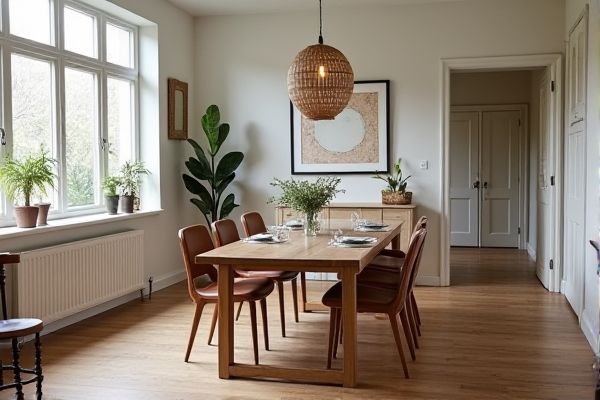
Mid-century tables showcase sleek, minimalist designs with clean lines and tapered legs, perfect for a modern, stylish look, while farmhouse tables emphasize rustic charm through sturdy construction and distressed wood finishes, ideal for a cozy, inviting atmosphere. Discover how to choose the perfect table style for Your home by reading the rest of the article.
Table of Comparison
| Feature | Mid-Century Table | Farmhouse Table |
|---|---|---|
| Design Style | Minimalist, sleek lines, retro | Rustic, traditional, cozy |
| Materials | Teak, walnut, plywood | Solid wood, reclaimed wood, pine |
| Shape | Rectangular, round, oval | Rectangular, large slabs |
| Leg Style | Tapered, angled legs | Sturdy, thick legs or trestle base |
| Finish | Glossy or matte veneers | Distressed, natural wood grain |
| Usage | Modern interiors, compact spaces | Casual dining, family gatherings |
| Price Range | Medium to high | Low to medium |
| Maintenance | Requires gentle care, avoids moisture | Durable, can be refinished easily |
Introduction to Mid-Century and Farmhouse Tables
Mid-century tables are characterized by clean lines, organic shapes, and minimalist design, reflecting the modernist aesthetic of the 1940s to 1960s. Farmhouse tables emphasize rustic charm with sturdy construction, often featuring reclaimed wood and a distressed finish that highlights craftsmanship and tradition. Both styles serve distinct decor purposes, with mid-century tables fitting contemporary interiors and farmhouse tables enhancing cozy, country-inspired spaces.
Defining the Mid-Century Table Style
Mid-century tables are defined by their clean lines, organic shapes, and emphasis on function combined with sleek aesthetics, often made from teak or walnut wood. Unlike farmhouse tables, which prioritize rustic charm and sturdiness through heavy wood and distressed finishes, mid-century designs feature tapered legs and minimal ornamentation to create a timeless, airy look. Choosing a mid-century table enhances Your space with a blend of retro elegance and modern simplicity.
Key Characteristics of Farmhouse Tables
Farmhouse tables are characterized by their sturdy construction, often made from solid wood with a rustic, distressed finish that highlights natural grain patterns. They typically feature thick, chunky legs and a spacious rectangular top designed for communal dining and durability. Unlike the sleek, minimalist design of mid-century tables, farmhouse tables emphasize warmth, practicality, and a handcrafted aesthetic.
Materials Used in Mid-Century vs Farmhouse Tables
Mid-century tables primarily feature materials such as teak, walnut, and rosewood combined with sleek metal or hairpin legs, emphasizing minimalist design and natural wood grain. Farmhouse tables typically use solid hardwoods like oak, pine, or reclaimed wood, highlighting durability and a rustic, handcrafted appearance. The contrast lies in mid-century's focus on smooth, polished finishes and organic shapes, whereas farmhouse tables prioritize rugged textures and sturdy construction.
Color Palettes and Finishes Compared
Mid-century tables typically feature warm, natural wood tones with sleek, smooth finishes emphasizing walnut, teak, and oak, often complemented by muted color palettes like olive green, mustard yellow, and burnt orange. Farmhouse tables embrace rustic, distressed finishes in white, cream, and pastel shades, highlighting weathered wood textures and chipped paint for a cozy, vintage appeal. The contrast between mid-century's polished, minimalist aesthetic and farmhouse's rough, textured surfaces defines their distinctive design identities.
Functional Differences: Practicality and Usage
Mid-century tables are characterized by sleek, minimalist designs with clean lines and often use lightweight materials, making them ideal for smaller spaces and modern aesthetics. Farmhouse tables emphasize durability and rustic charm, constructed with sturdy wood and designed to accommodate large gatherings, making them practical for family-oriented and high-traffic dining areas. The mid-century table prioritizes versatility and style, while the farmhouse table focuses on robustness and communal use.
Aesthetic Appeal in Modern Interiors
Mid-century tables feature sleek lines, tapered legs, and minimalist design, offering a timeless aesthetic that complements modern interiors with a clean and sophisticated look. Farmhouse tables provide a rustic charm through their sturdy construction, distressed finishes, and warm wood tones, creating a cozy and inviting atmosphere in contemporary spaces. Both styles enhance modern interiors by balancing functionality with distinctive visual character, allowing for versatile design integration.
Durability and Maintenance Considerations
Mid-century tables typically feature sleek, minimalist designs with hardwoods like teak or walnut, offering high durability and requiring regular polishing to maintain their finish. Farmhouse tables, often constructed from solid pine or oak, stand out for their robust build and resistance to wear but may demand more frequent sealing or waxing to protect against moisture and scratches. Your choice should consider the maintenance routine you can commit to, as mid-century tables often need more gentle care, while farmhouse styles tolerate heavier use but require proactive upkeep.
Which Table Fits Your Space?
Mid-century tables feature sleek, minimalist designs with tapered legs and smooth edges, making them ideal for modern, compact spaces that prioritize clean lines and functionality. Farmhouse tables offer robust, rustic aesthetics with sturdy construction and distressed wood finishes, perfect for larger dining areas seeking a warm, inviting atmosphere. Choosing between them depends on the room's size, existing decor, and the desired balance between contemporary elegance and traditional comfort.
Final Thoughts: Choosing Between Mid-Century and Farmhouse Tables
Mid-century tables offer sleek, minimalist designs with tapered legs and smooth finishes, perfect for modern and retro-inspired interiors. Farmhouse tables emphasize rustic charm and durability, often crafted from reclaimed wood with a sturdy, handcrafted look that suits cozy, traditional spaces. Choosing between the two depends on your home's aesthetic and functional needs, balancing contemporary elegance with timeless, rustic warmth.
 homyna.com
homyna.com